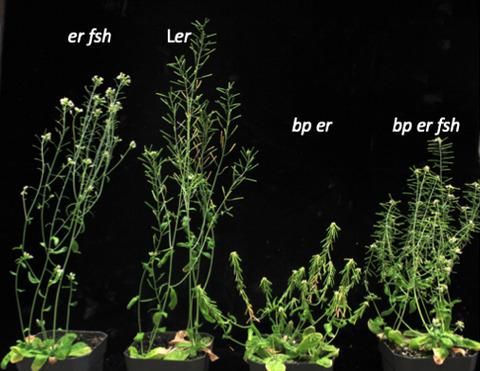Our official English website, www.x-mol.net, welcomes your
feedback! (Note: you will need to create a separate account there.)
flasher, a novel mutation in a glucosinolate modifying enzyme, conditions changes in plant architecture and hormone homeostasis.
The Plant Journal ( IF 6.2 ) Pub Date : 2020-06-12 , DOI: 10.1111/tpj.14878 Ameth N Garrido 1 , Esther Supijono 1 , Peter Boshara 1 , Scott J Douglas 1 , Patti E Stronghill 1 , Baohua Li 2 , Eiji Nambara 3 , Daniel J Kliebenstein 4 , C Daniel Riggs 1, 2
The Plant Journal ( IF 6.2 ) Pub Date : 2020-06-12 , DOI: 10.1111/tpj.14878 Ameth N Garrido 1 , Esther Supijono 1 , Peter Boshara 1 , Scott J Douglas 1 , Patti E Stronghill 1 , Baohua Li 2 , Eiji Nambara 3 , Daniel J Kliebenstein 4 , C Daniel Riggs 1, 2
Affiliation

|
Meristem function is underpinned by numerous genes that affect hormone levels, ultimately controlling phyllotaxy, the transition to flowering and general growth properties. Class I KNOX genes are major contributors to this process, promoting cytokinin biosynthesis but repressing gibberellin production to condition a replication competent state. We identified a suppressor mutant of the KNOX1 mutant brevipedicellus (bp) that we termed flasher (fsh), which promotes stem and pedicel elongation, suppresses early senescence, and negatively affects reproductive development. Map‐based cloning and complementation tests revealed that fsh is due to an E40K change in the flavin monooxygenase GS‐OX5, a gene encoding a glucosinolate (GSL) modifying enzyme. In vitro enzymatic assays revealed that fsh poorly converts substrate to product, yet the levels of several GSLs are higher in the suppressor line, implicating FSH in feedback control of GSL flux. FSH is expressed predominantly in the vasculature in patterns that do not significantly overlap those of BP, implying a non‐cell autonomous mode of meristem control via one or more GSL metabolites. Hormone analyses revealed that cytokinin levels are low in bp, but fsh restores cytokinin levels to near normal by activating cytokinin biosynthesis genes. In addition, jasmonate levels in the fsh suppressor are significantly lower than in bp, which is likely due to elevated expression of JA inactivating genes. These observations suggest the involvement of the GSL pathway in generating one or more negative effectors of growth that influence inflorescence architecture and fecundity by altering the balance of hormonal regulators.
中文翻译:

闪光剂,是芥子油苷修饰酶中的一种新型突变,可改变植物结构和荷尔蒙稳态。
分生组织功能由许多影响激素水平的基因来支撑,这些基因最终控制叶序,向开花的过渡和总体生长特性。I类KNOX基因是此过程的主要贡献者,可促进细胞分裂素的生物合成,但抑制赤霉素的产生以调节复制能力。我们确定了KNOX1突变体brevipedicellus(bp)的抑制突变体,我们称其为flasher(fsh),该突变体促进茎和花梗的伸长,抑制早期衰老,并对生殖发育产生负面影响。基于图的克隆和互补测试表明fsh是由于黄素单加氧酶的E40K变化GS‐OX5,一种编码芥子油苷(GSL)修饰酶的基因。体外酶法测定显示,fsh很难将底物转化为产物,但抑制线中几种GSL的水平较高,这意味着FSH参与了对GSL通量的反馈控制。FSH主要在脉管系统中表达,与BP的模式没有明显重叠,这意味着通过一种或多种GSL代谢物的分生组织控制的非细胞自主模式。激素分析显示,细胞分裂素水平的bp较低,但是fsh通过激活细胞分裂素生物合成基因将细胞分裂素水平恢复至接近正常水平。此外,茉莉fsh抑制子显着低于bp中的抑制子,这可能是由于JA失活基因表达升高所致。这些观察结果表明,GSL途径参与产生一种或多种生长的负效应物,其通过改变激素调节剂的平衡来影响花序结构和繁殖力。
更新日期:2020-06-12
中文翻译:

闪光剂,是芥子油苷修饰酶中的一种新型突变,可改变植物结构和荷尔蒙稳态。
分生组织功能由许多影响激素水平的基因来支撑,这些基因最终控制叶序,向开花的过渡和总体生长特性。I类KNOX基因是此过程的主要贡献者,可促进细胞分裂素的生物合成,但抑制赤霉素的产生以调节复制能力。我们确定了KNOX1突变体brevipedicellus(bp)的抑制突变体,我们称其为flasher(fsh),该突变体促进茎和花梗的伸长,抑制早期衰老,并对生殖发育产生负面影响。基于图的克隆和互补测试表明fsh是由于黄素单加氧酶的E40K变化GS‐OX5,一种编码芥子油苷(GSL)修饰酶的基因。体外酶法测定显示,fsh很难将底物转化为产物,但抑制线中几种GSL的水平较高,这意味着FSH参与了对GSL通量的反馈控制。FSH主要在脉管系统中表达,与BP的模式没有明显重叠,这意味着通过一种或多种GSL代谢物的分生组织控制的非细胞自主模式。激素分析显示,细胞分裂素水平的bp较低,但是fsh通过激活细胞分裂素生物合成基因将细胞分裂素水平恢复至接近正常水平。此外,茉莉fsh抑制子显着低于bp中的抑制子,这可能是由于JA失活基因表达升高所致。这些观察结果表明,GSL途径参与产生一种或多种生长的负效应物,其通过改变激素调节剂的平衡来影响花序结构和繁殖力。











































 京公网安备 11010802027423号
京公网安备 11010802027423号